Getting to Sesame Street With the FIRST LADIES
 DIANA BARTELLI CARLIN
DIANA BARTELLI CARLIN
47
OPPOSITE: GEORGE H.W. BUSH PRESIDENTIAL LIBRARY AND MUSEUM / RIGHT: AP IMAGES
take an 8-foot canary, several endearing puppets known as Muppets, animation mixed with live videos of a diverse group of preschoolers, catchy tunes often resembling advertising jingles, a cast of human characters in a welcoming neigh borhood, and an ordinary looking street—and what you have is a formula for one of the most enduring and successful examples of television’s power to teach as well as entertain. Sesame Street, through its beloved characters, has long found a place in the White House that cuts across political party lines. Sherrie Westin, current president of the nonprofit Sesame Workshop and a member of the George H. W. Bush administration, explains why the partner ship works: “I think it’s been because we’ve always focused on the needs of young children, and so that’s not a partisan issue. That’s something we can all agree on. I think it’s because we’ve stayed true to our mission and focused on what is in the best interest of preschoolers, and with particular pro grams, it is a natural alignment. There is no politi cal focus on one administration over another.”1
When Sesame Street premiered on November 10, 1969, it was the product of a collaboration between award-winning documentary producer Joan Ganz Cooney and Lloyd Morrisett, a psychologist and Carnegie Corporation vice president. Inspired by a dinner party conversation about Morrisett’s daughter’s infatuation with television—including the test patterns ahead of the real show—the two set out to answer this question: Do you think tele vision could be used to teach young children?2 At the time, Carnegie was funding research on early childhood education, especially for children from disadvantaged environments who were unpre pared for school success. Through Carnegie fund ing, Cooney consulted with experts on television’s teaching potential and created a concept that has educated children and helped adults educate chil dren, including through White House collabora tions, for more than fifty years.
The rich history of the intersection of Sesame Street and 1600 Pennsylvania Avenue demon strates the ongoing commitment of presidents and first ladies to children and their recognition of television’s power to enhance that commitment. Cast and characters’ visits to White House holiday parties and special events align with Sesame Street’s mission to promote literacy and basic math and sci ence skills. Appearances by first ladies on the show enhance the show’s mission and advance White
House projects. Even after presidential families leave the White House, collaborations continue.
THE BEGINNINGS
Less than two months after Sesame Street first aired, Daniel Patrick Moynihan, counselor to the presi dent and member of the Domestic Policy Council, sent a memorandum to President Richard Nixon’s staff secretary with a suggestion that began the long relationship between the children’s televi sion show and the White House. Moynihan wrote: “The new program called Sesame Street on National Educational Television has already shown itself to be so popular and so well done that I think the President would want to send a note to its director. We would be happy to provide additional informa tion if you like.”3
Three weeks later, Nixon sent a letter to Cooney:
The many children and families now bene ting from Sesame Street are participants in one of the most promising experiments in the history of that medium. The Children’s Television Workshop certainly deserves the high praise it has been getting from young and old alike in every corner of the nation.
This administration is enthusiastically committed to opening up opportunities for every youngster, particularly during his rst ve years of life, and is pleased to be among the sponsors of your distinguished program.4
This letter was not a perfunctory congratulatory message. Moynihan, an academic, understood the show’s potential societal impact. The administra tion’s proponents included First Lady Pat Nixon, whose office arranged for the first Sesame Street White House visit. One memorandum indicated that Mrs. Nixon’s staff requested a performance by several Muppets, but Sesame Street staff thought they were too small to be seen by the large crowd and offered Big Bird and possibly Oscar the Grouch.5 The White House news release about the event provided background on the show’s develop ment and mission and announced, “Sesame Street, TV’s gift to children, will be a special Christmas gift for the children attending the annual Diplomatic Children’s Party on Tuesday, December 22 [1970], at the White House.”6 The five hundred attend ees were treated to a twenty-minute program in the East Room. The event produced an iconic
opposite Big Bird meets First Lady Pat Nixon on his rst visit to the White House, December 1970.
previous spread
First Lady Barbara Bush was the rst rst lady to appear on Sesame Street. She is seen here in Episode 2660 with Big Bird, the Count, and children reading Peter’s Chair, 1989.
First Lady Michelle Obama, seen here with Elmo in 2013, often welcomed the Muppets to the White House.
48
white house history quarterly
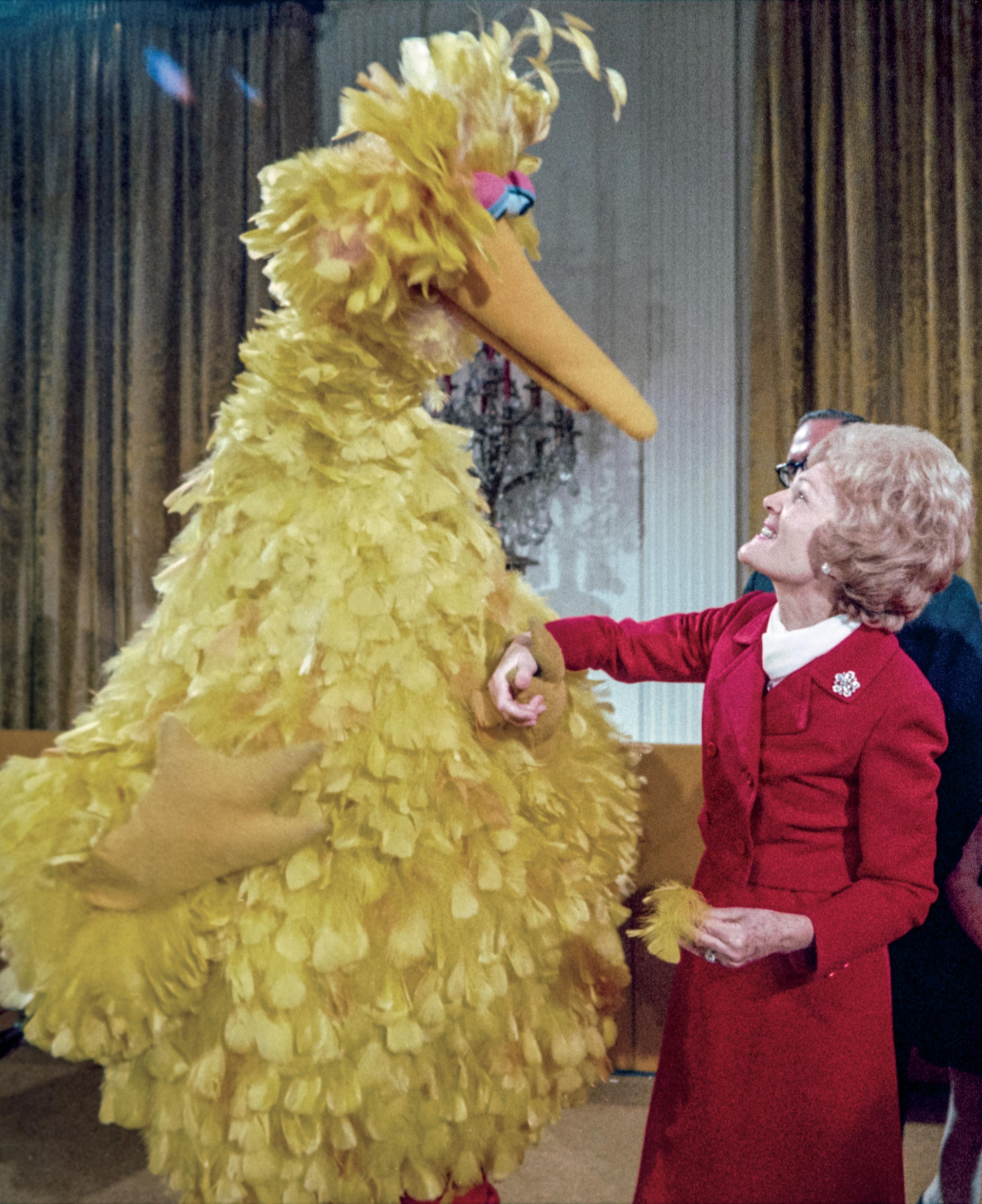
49 white house history quarterly
RICHARD M. NIXON PRESIDENTIAL LIBRARY AND MUSEUM
photograph of a smiling Pat Nixon looking up at Big Bird while holding one of his feathers. President Nixon sent a thank-you letter to Jason L. Levine, director of public relations for the Children’s Television Workshop, describing the performance as “a special pleasure” and “a highlight of our party for Diplomatic Children.”7
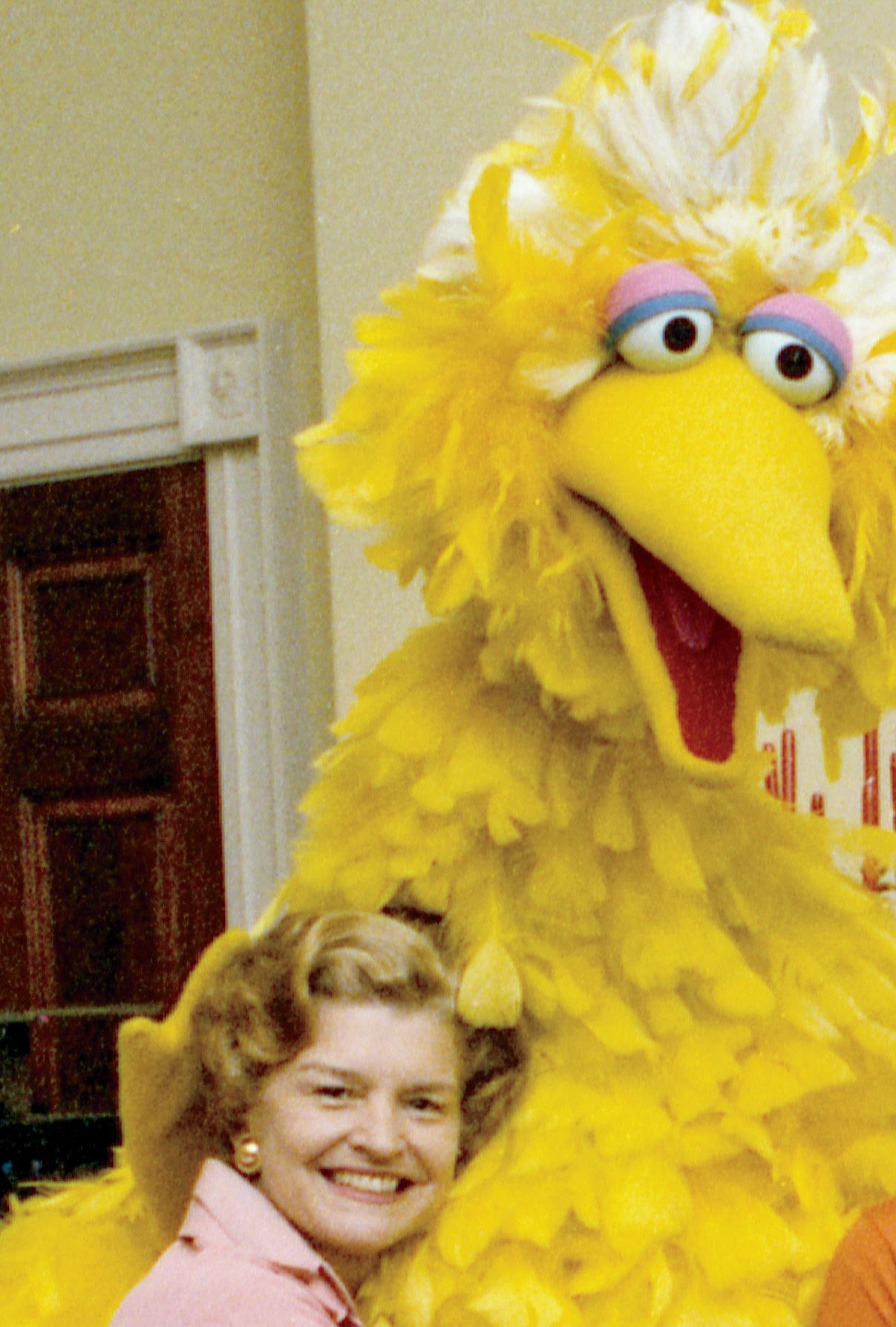
The next three administrations—Gerald R. Ford, Jimmy Carter, and Ronald Reagan—followed the Nixons’ lead and provided a venue for the program to display its special brand of tested learning strat egies in a spotlight only the White House can pro vide. Sesame Street appeared at the 1976 and 1978 Diplomatic Corps children’s party and at a chil dren’s holiday program during the Reagan admin istration. The Reagans also included Muppets and their human friends as part of the annual Easter Egg Roll. With hundreds of children in attendance and media coverage, the Easter Egg Roll is a natu ral event for collaborations. In addition to eggs to roll, there are books for characters and cast to read, games to play, and songs to perform.
It was during the Reagan administration that the show’s cultural and diplomatic power was emphasized. Prior to attending a summit in Geneva
with the new Soviet leader, Mikhail Gorbachev, President Ronald Reagan addressed the nation from the Oval Office. In describing his hopes for his “mission of peace,” he expressed the belief that greater trust could be built on personal contact between ordinary citizens of both countries. He imagined what it would be like if, for example, “peo ple in our Nation could see the Bolshoi Ballet again, while Soviet citizens could see American plays and hear groups like the Beach Boys. And how about Soviet children watching Sesame Street.”8 Today, children in former Soviet states along with children in 150 countries, including thirty with international versions, are watching Sesame Street
Big Bird is greeted by First Lady Betty Ford and First Lady Rosalynn Carter (above) on return holiday visits to the White House to entertain children of the Diplomatic Corps in 1976 and 1978, and he dances with Muppets in the East Room during a holiday children’s party hosted by First Lady Nancy Reagan (opposite).
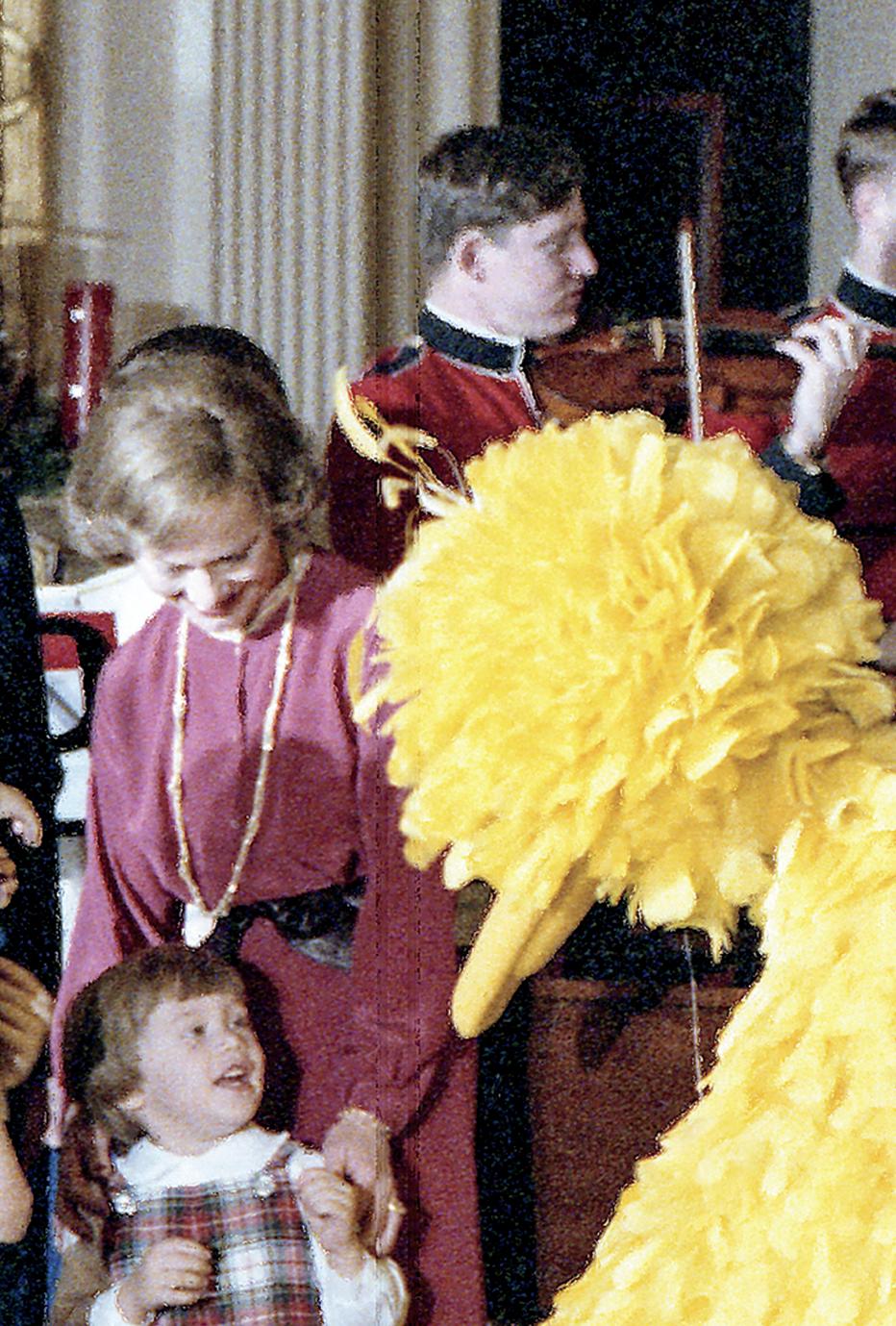
50
OPPOSITE:
TOP LEFT: GERALD R. FORD PRESIDENTIAL LIBRARY AND MUSEUM / TOP RIGHT: JIMMY CARTER PRESIDENTIAL LIBRARY AND MUSEUM
RONALD REAGAN PRESIDENTIAL LIBRARY AND MUSEUM
white house history quarterly
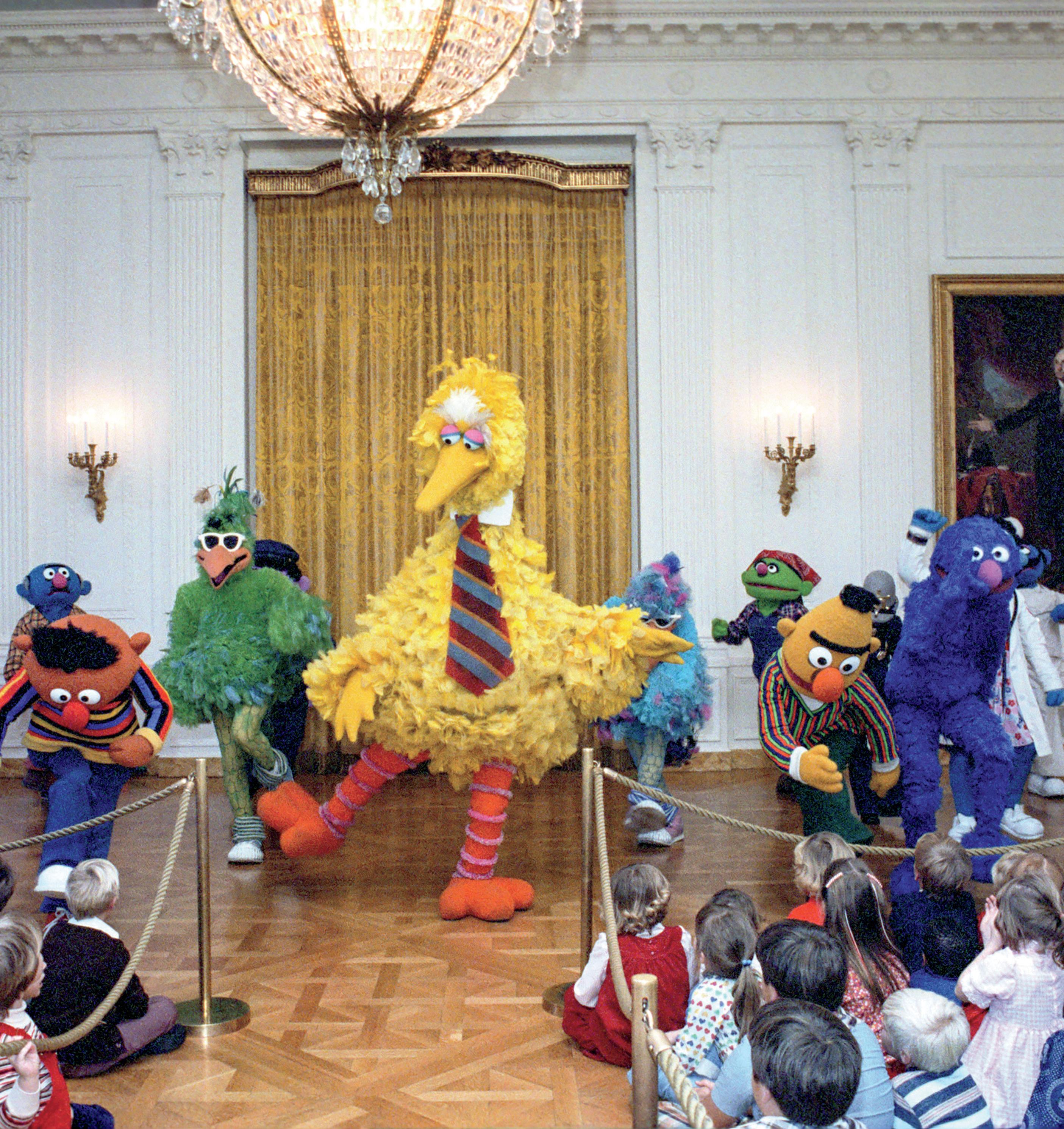
51 white house history quarterly
BARBARA BUSH : ANOTHER LEVEL
If Sesame Street were tailor made for collaboration with a single administration, it would be that of George H. W. Bush. With First Lady Barbara Bush’s emphasis on literacy and the establishment in 1989 of the Barbara Bush Foundation for Family Literacy, the continued partnership was all but guaranteed. Mrs. Bush chose literacy as her emphasis because she connected many of the domestic problems her husband’s administration confronted, such as pov erty, addiction, and crime, to a lack of literacy, an inability to “read, write and comprehend.” 9 The Bush administration’s commitment was sealed in 1991 with passage of the National Literacy Act, which assists adults in completing secondary school. While Sesame Street is for preschoolers, Westin explained that “part of the genius of Joan Ganz Cooney was that she deliberately had [adult] music and humor, and she knew the learning would be deeper if an adult were watching as well as the child.”10 Mrs. Bush’s foundation emphasizes the family role in literacy for both children and adults, and Sesame Street reinforces that dynamic.


52
white house history quarterly BOTH IMAGES THIS PAGE:
GEORGE
H. W. BUSH PRESIDENTIAL LIBRARY AND MUSEUM
First Lady Barbara Bush is joined by Count von Count and Big Bird as she reads to children on the set of Sesame Street, 1989
This photograph of Kermit the Frog with PresidentElect Bill Clinton and Hillary Rodham Clinton made front page news. The Clintons are seen singing with Kermit during a pre-inaugural children’s event at the Kennedy Center, January 19, 1993.
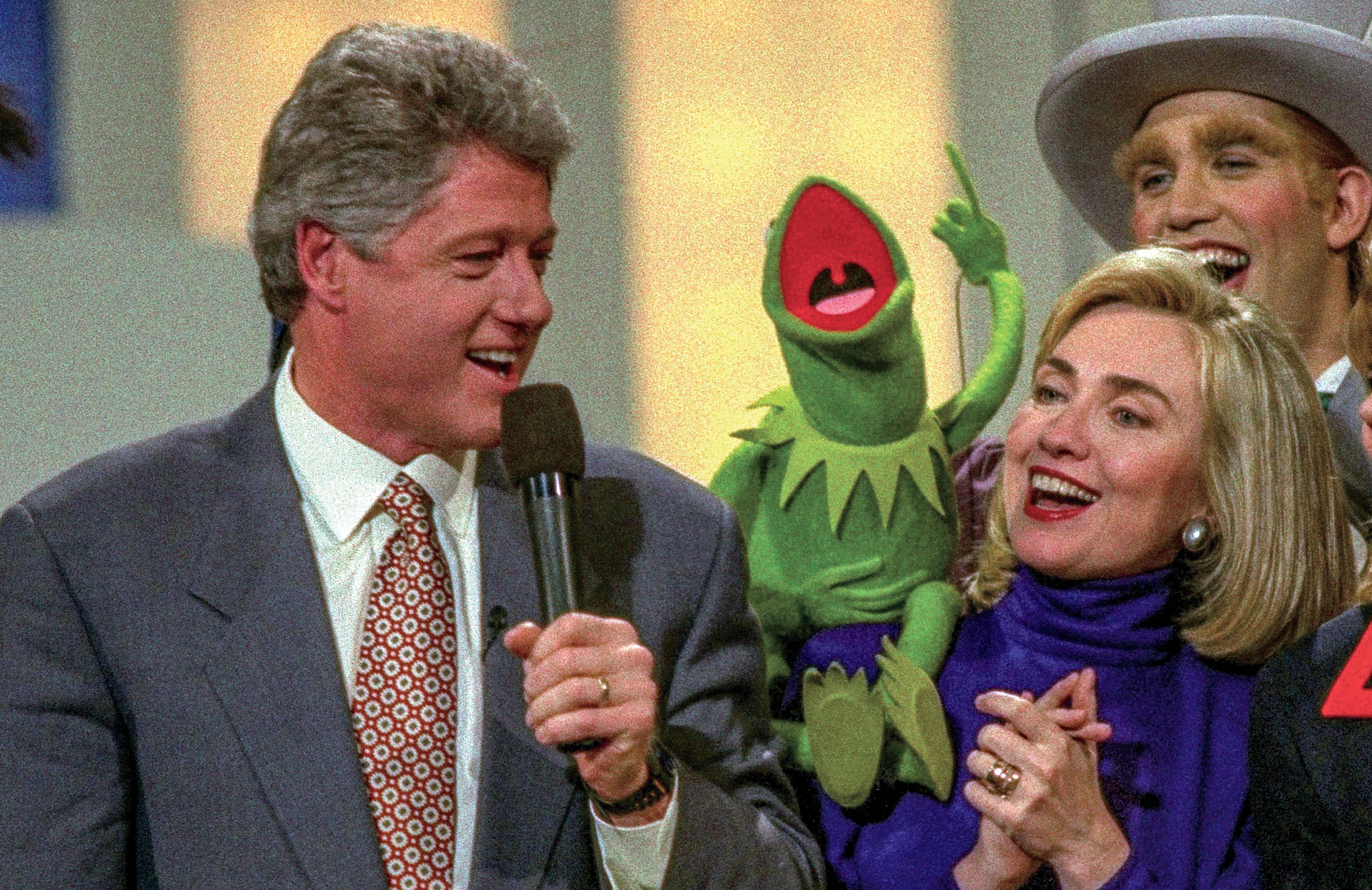
The White House–Sesame Street partnerships expanded to the production itself when Barbara Bush, surrounded by Muppets and neighborhood children, appeared on the show reading Peter’s Chair by Ezra Jack Keats. She later lent her sing ing talents to the documentary Sing! Sesame Street Remembers Joe Raposo and His Music by joining in for a rendition of “Sing.” Mrs. Bush’s appear ance began a tradition that continued through the Barack Obama administration.
THE CLINTON YEARS
Even before Bill Clinton was officially president, he and Hillary Rodham Clinton signaled their inten tions to partner with Sesame Street. As part of the pre-inaugural activities, they hosted an Inaugural Celebration for Children at the Kennedy Center that featured Kermit, Gonzo, and Rizzo. The con cert ended with a group sing during which puppe teer Steve Whitmire “crouched down behind the Clintons, perching Kermit up on Hillary’s shoul der as they sang. The camera held for a minute or so on this scene, and an AP photo of Kermit on
Hillary’s shoulder appeared on front pages around the nation,” reported the website Muppet Wiki. Two years later, Hillary Clinton hosted Big Bird and Alice Snuffleupagus among the sculptures in the Jacqueline Kennedy Garden to call attention to the value of public broadcasting at a time when federal funding for public television was under fire in Congress.11 She appeared on the show in 1993 to talk about healthy life-styles, and her photograph with Big Bird appeared on the cover of TV Guide.
The Clinton years saw the highly popular book series about careers featuring Muppets add I Want to Be President, by Michaela Muntean. It follows Muppet Betty Lou’s imaginary rise to the presi dency after being inspired by watching the “real” president give a speech. In the book, Betty Lou performs many of the typical presidential tasks, including hosting the Easter Egg Roll. In 1995, in a demonstration of the show’s importance and impact, President Clinton presented Joan Ganz Cooney with the Presidential Medal of Freedom in an East Room ceremony.
53 white house history quarterly AP IMAGES
First Lady Laura Bush meets cast members from Galli Galli Sim Sim, the Indian version of Sesame Street, at their studio on the outskirts of New Delhi, March 2006.
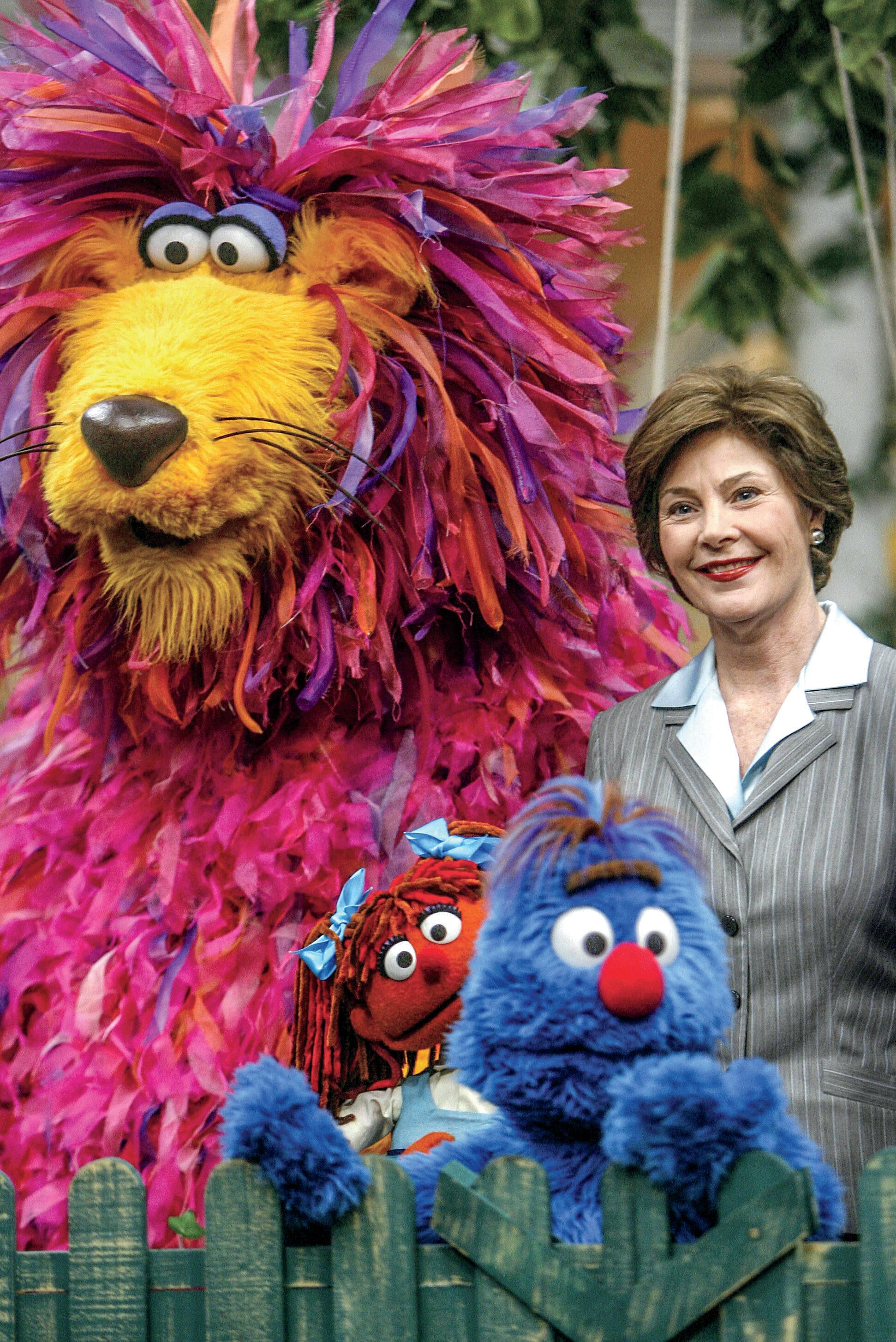
54
ALL IMAGES THIS SPREAD: GETTY IMAGES white house history quarterly
Mrs. Bush talks with Egyptian Sesame Street character Khokha before taping a segment in Giza, May 2005.
Mrs. Bush laughs with Big Bird and Elmo while taping Sesame Street in New York, 2002. The children, Sydney Martines and Sienna Je eries, read a book with Mrs. Bush.
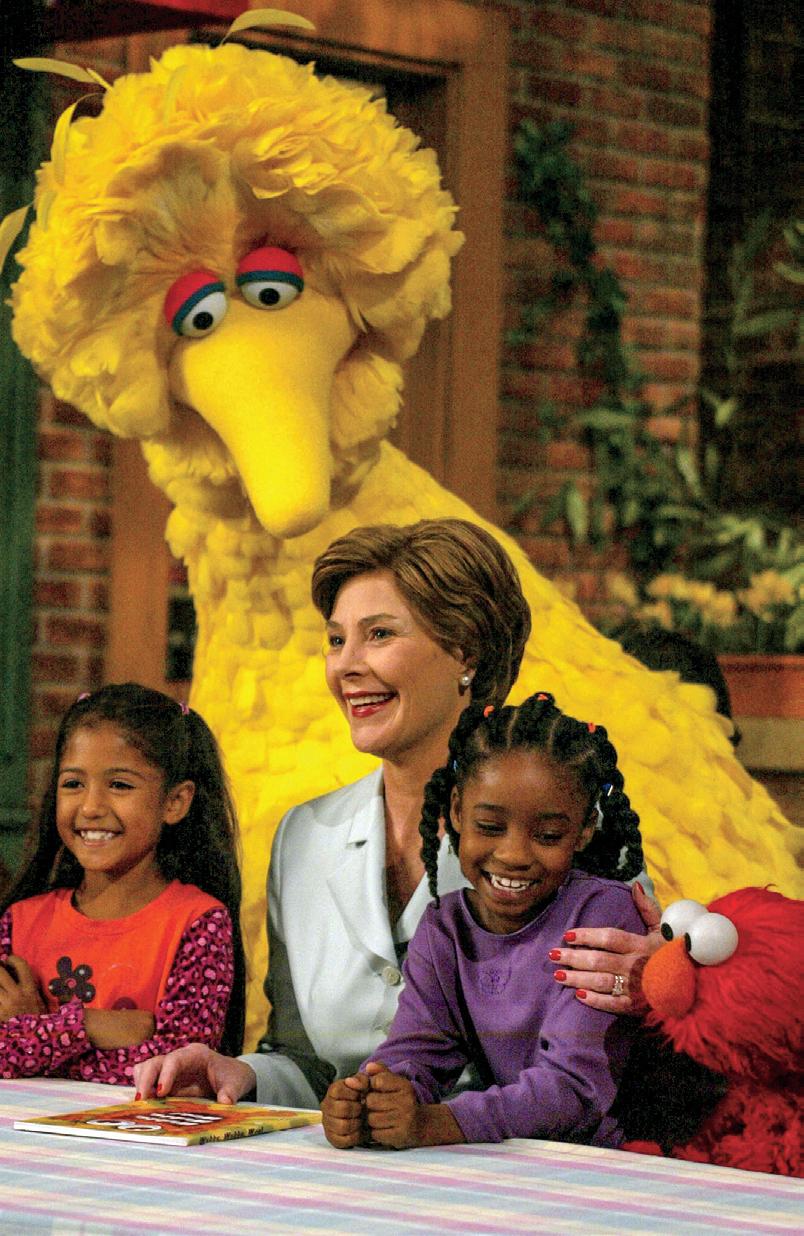
THE GEORGE W. BUSH ADMINISTRATION
If the first Bush administration elevated the stature of Sesame Street and further enhanced the mutual benefits of collaborations, the sec ond Bush administration went even further; The George W. Bush administration’s priorities included a portfolio of educational initiatives. Both the president and First Lady Laura Bush saw the value of using Sesame Street characters when they rolled out an early childhood learning program called Ready to Learn. In his remarks, President Bush made humorous references to the letter “W,” in the same way the show teaches individual letters, by joking that his mother used to say, “The trou ble with W.”12 Laura Bush, a former teacher and librarian who also stressed literacy, often included cast and characters at the National Book Festival, which she co-founded in 2001 with Librarian of Congress James H. Billington. Sesame Street char acters also read, sang, and greeted attendees at the annual Easter Egg Roll. The Bushes invited char acters to join them at children’s holiday receptions and Christmas tree lightings. In 2002, in an Oval Office ceremony, President George W. Bush pre sented Cooney with a second award, the National Endowment for Humanities National Humanities Medal.

The Bushes also recognized Sesame Street’s growing worldwide influence, and Laura Bush was
at the forefront of promoting the program’s global reach. The alignment between Sesame Street val ues and White House priorities focused on two issues—education and literacy, and global health— according to Mrs. Bush’s former chief of staff, Anita McBride. McBride noted that the long-standing relationship with the program brought Sesame Street “to the White House to create these char acters around these two issues to be inaugurated or established or unveiled in several countries.” Through visits to India, Pakistan, and Egypt, Mrs. Bush found a way “to amplify the foreign policy objectives of global education and global health, particularly in India where the marginalized pop ulation would see these characters on TV who were not from the upper crust of society. It was helpful in breaking some barriers,” said McBride.13 Back in Washington, on May 9, 2006, Mrs. Bush and Jordan’s Queen Rania Al-Abdullah posed with Elmo and Khokha, a Muppet from the Egyptian program, to highlight the Mosaic Foundation’s partnership with Sesame Workshop that aimed to expand the program in the Arab world.14 Mrs. Bush wrote about her international work with Sesame Street in her memoir Spoken from the Heart. Her visit to Alam Simsim, the Egyptian co-production of Sesame Street, reached “85 percent of Egypt’s pre schoolers and 54 percent of their mothers. . . . An appearance there had the potential to reach more ordinary citizens than high-level summitry.”15
55
white house history quarterly
THE OBAMA YEARS
The first first couple to grow up watching Sesame Street were the Obamas. Mrs. Obama relished her experiences with the characters at the White House and on the set. She called her first appearance on the show, on May 9, 2009, “probably the best thing I’ve done so far in the White House,” even though she had met Queen Elizabeth II and was speaking at the United Nations that same day.16 Her appear ance taught kids how to plant a garden like hers at the White House and emphasized the importance of nutrition and healthy eating. Five years later she appeared again discussing the importance of a healthy breakfast with Grover. In 2011 she and Dr. Jill Biden, the wife of the vice president, appeared to promote Joining Forces, a White House initiative to support military families. Elmo and Grover each
visited the White House to promote healthy eating, and Big Bird was at the White House to tape one of two public service announcements promoting the Mrs. Obama’s Let’s Move! campaign to curb child hood obesity. Elmo and Rosita joined the first lady in the State Dining Room for a news conference about the campaign as part of Sesame Workshop’s decision to allow the Muppets to help market fruits and vegetables to children.
In 2019 Mrs. Obama received the Joan Ganz Cooney Award at the Sesame Workshop fundraising gala as part of the program’s fiftieth anniver sary celebration. Commenting on growing up with the show and watching her daughters do the same, she described the program as “genius, all of it—not just feel-good TV but some of the smartest, savviest developmental tools you can offer your child.”17
Clockwise from left: Elmo joins Michelle Obama for a Let’s Move announcement in the East Room, 2013; Mrs. Obama reads with Miss Piggy during the 2015 Christmas Tree Lighting Ceremony; and Kermit the Frog joins Mrs. Obama prior to a screening of Disney’s Muppets Most Wanted movie as part of the Joining Forces initiative.
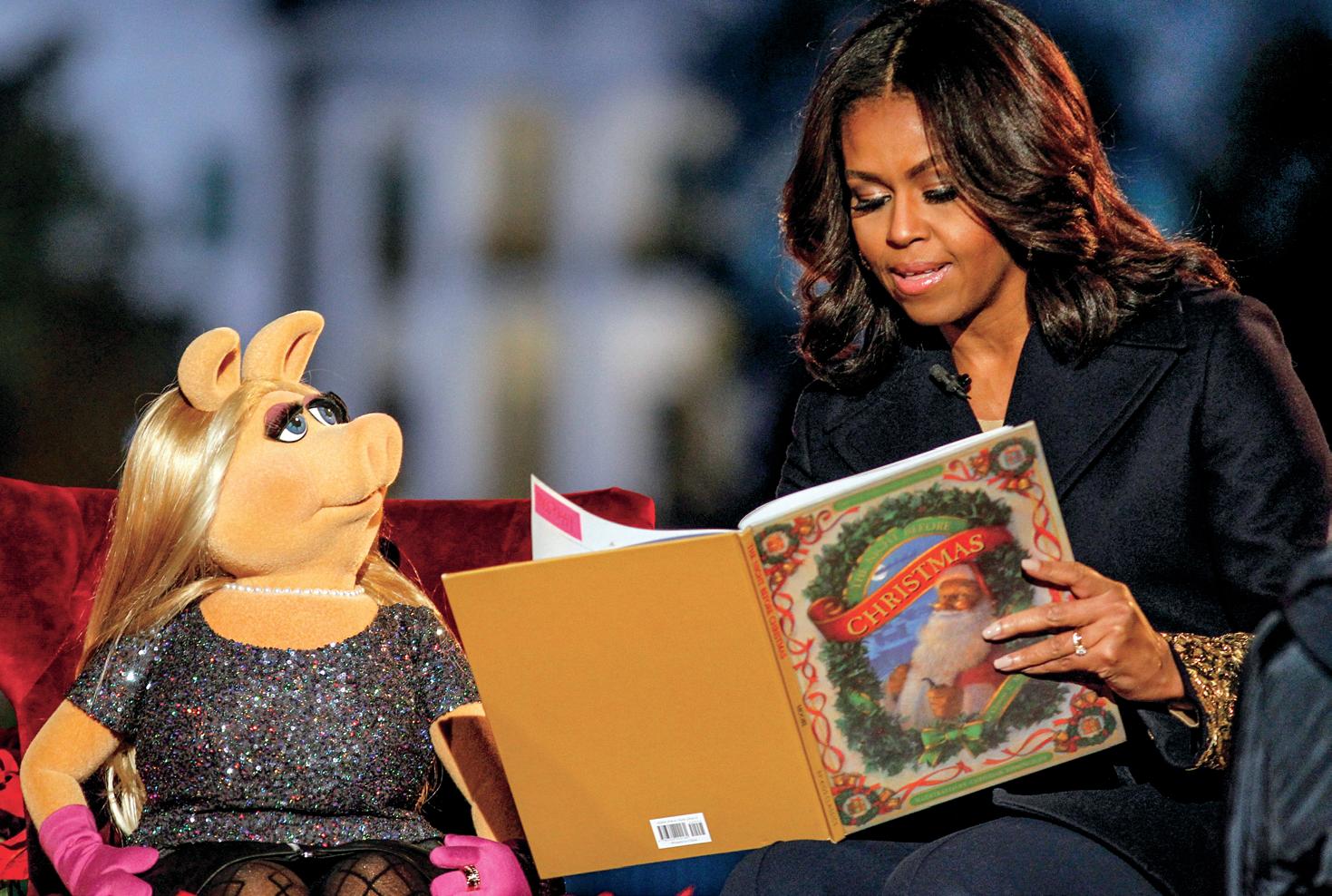
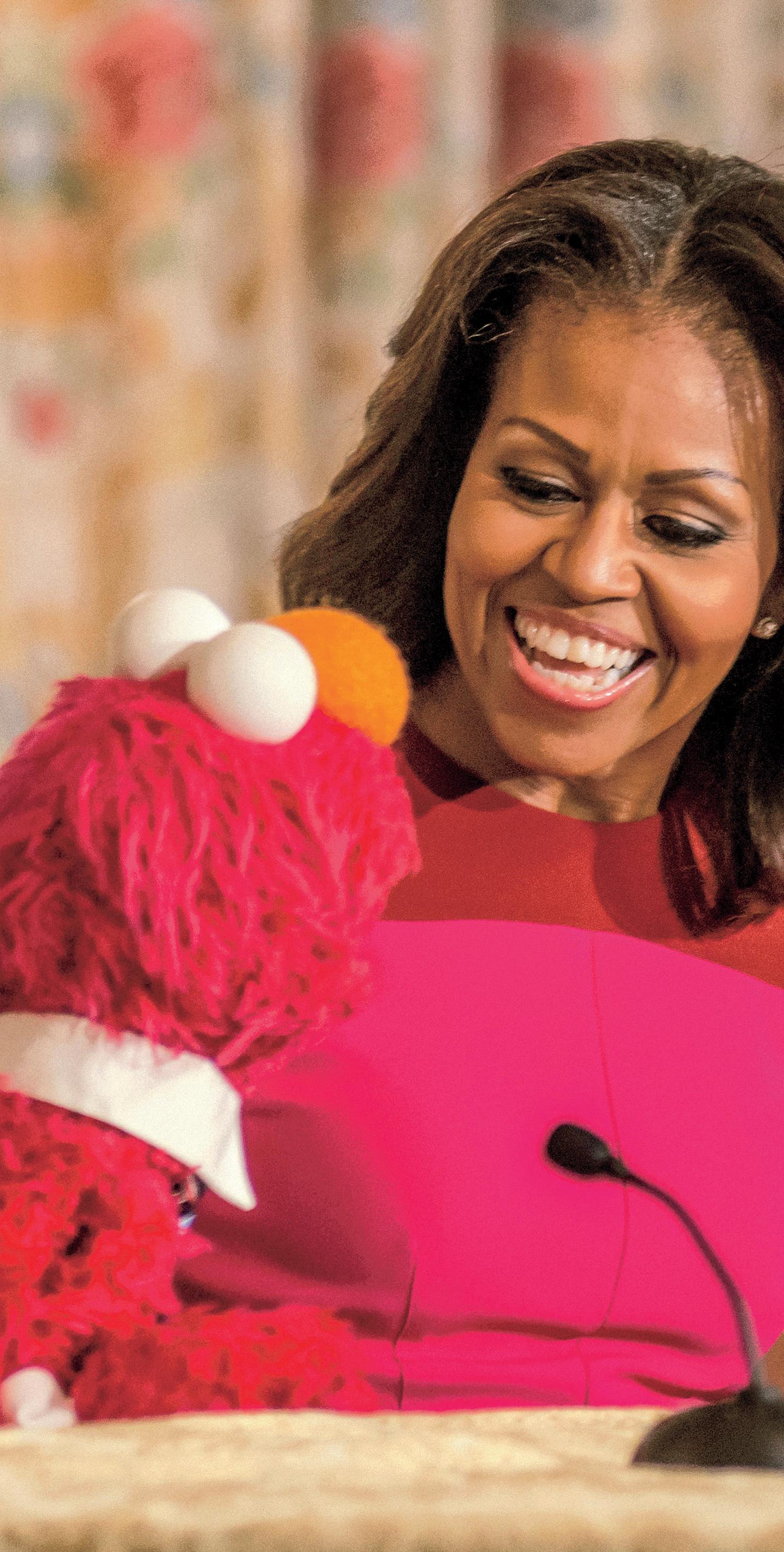
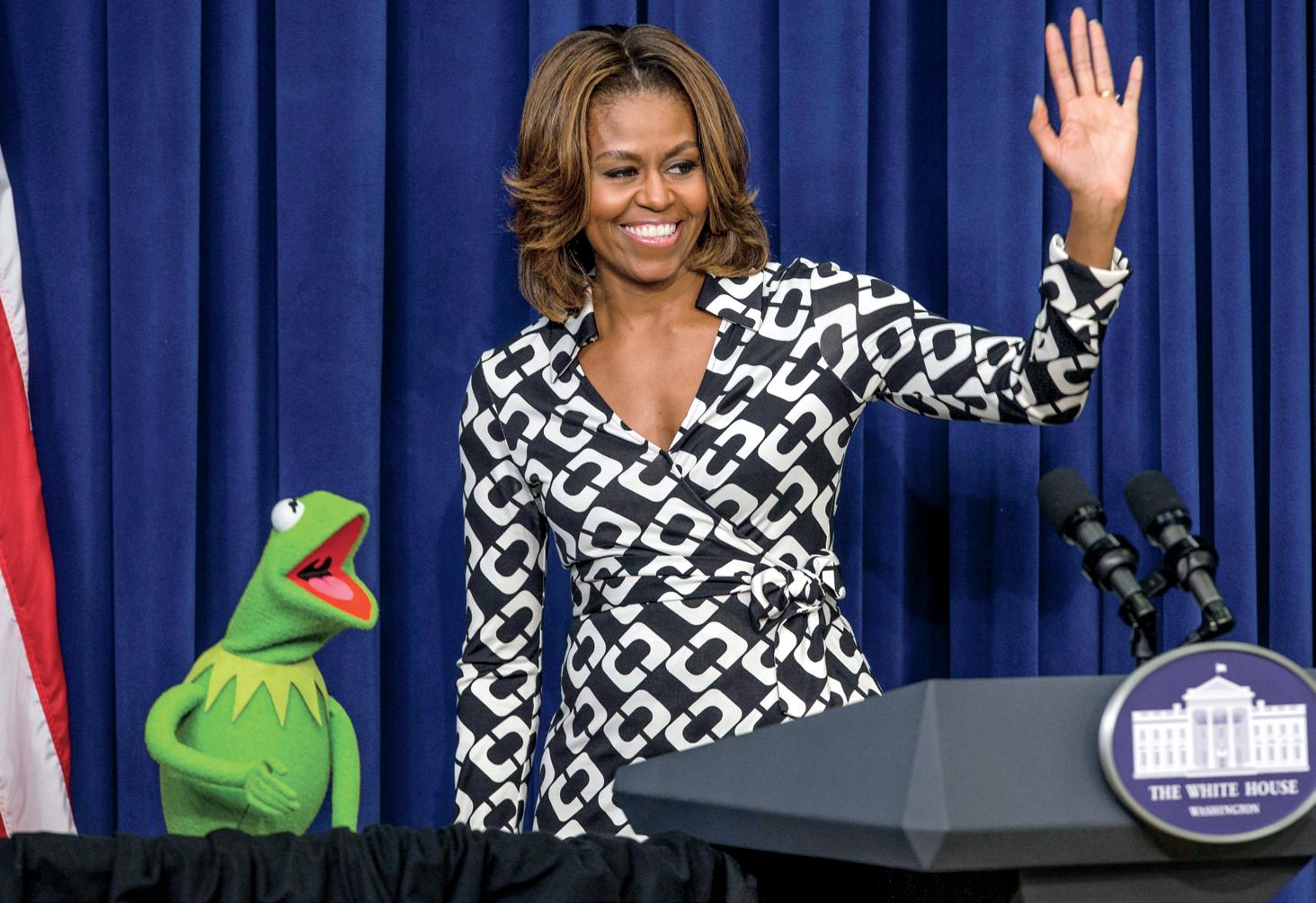
56
white house history quarterly
CLOCKWISE FROM LEFT: ALAMY / GETTY IMAGES / AP IMAGES
above
President and Mrs. Barack Obama pose with children and guests who joined in the 2016 harvest of the White House Kitchen Garden. Among the guests are Elmo and Rosita, astronaut Kjell Lindgren, NBC’s Al Roker and Sam Kass, and basketball star Alonzo Mourning, right

Rosita helps Mrs. Obama harvest broccoli in the White House Kitchen Garden, 2013.

57 white house history quarterly
BOTH PHOTOGRAPHS: GETTY IMAGES
CURRENT AND POST WHITE HOUSE COLLABORATIONS
Presidents and first ladies remain in the public eye long after they leave the White House and, through their foundations, continue their public service. Connections made while in office often continue as well, including those with Sesame Street. Laura Bush and Rosalynn Carter supported a USO–Sesame Street partnership started in 2008 to pro vide resources for military families that inspired the creation of the character Katie, who tours with the USO show. In 2017, Laura Bush recorded “A Special Message from a Sesame Friend” for mil itary families, acknowledging the difficult tran sitions children can face with a parent’s deploy ment or return.18 The Rosalynn Carter Institute for Caregiving (RCI) partnered with Sesame Workshop’s Operation Family Caregiver (OFC), a program designed for the needs of military fami lies. As a former military wife with young children, Rosalynn Carter could relate to the project.19
After leaving the White House, Laura Bush, together with Hillary Clinton, continued sup port of Sesame Workshop through Georgetown University’s U.S.–Afghan Women’s Council, serving as honorary co-chairs with Afghanistan’s first lady, Rula Ghani. Sesame Workshop’s Westin is a council member. Through their efforts, Sesame Workshop completed a project in Afghanistan started during the Bush administration. McBride, another council member, noted, “We knew from the data, obviously, from our own country the impact that this kind of program had on young kids for lifelong learning,” and it enabled the council and Sesame Workshop to “convey [messages] on global health, global lit eracy, access to education, and conflict resolution at young ages.”20
Current First Lady Jill Biden began her Sesame Street partnership when she was second lady. Westin noted that “Dr. Biden continued working on military families through the Biden Foundation and was an adviser for another one of our military family initiatives that helped military families tran sition back into civilian life and dealt with caregiv ers, which is such an important issue in terms of children’s well-being. . . . I hope that we will be able to work with her again on Joining Forces.”21 Dr. Biden appeared from the White House in ABC’s documentary on Sesame Street’s impact, 50 Years of Sunny Days, which aired April 26, 2021. In a
Zoom-like conversation with Muppet Rosita about the pandemic, Dr. Biden told Rosita there was room for optimism about life starting to return to normal. She was also shown in a clip on the show’s importance during a time when children were learning virtually.
Sesame Workshop took on the nation’s addic tion problem through a new Muppet named Karli, whose mother suffered from addiction. Workshop researchers contacted the Hazelden Betty Ford Foundation, a nonprofit addiction treatment cen ter, for advice, Westin said.22 Mrs. Ford had helped launch the foundation’s children’s program in 1983.23
One of the Clinton Foundation’s areas of empha sis is improving public health. In alignment with Sesame Street priorities, former President Bill Clinton assisted with World AIDS Day for UNICEF in 2006 by engaging in a conversation with Muppet Kami, who is HIV positive. Kami asked Clinton if he would “tell everybody that it is okay to hug someone who is HIV positive like me.” The former president assured her he would pass along the message and gave her a hug.24 Senator Hillary Clinton recorded a message with Elmo and Rosita for the Healthy Habits for Life initiative in 2005, and in 2014 she was featured in an episode of Dr. Sanjay Gupta’s CNN program, discussing early childhood learn ing and why Sesame Street works with Rosemarie Truglio from Children’s Television Workshop.25
below
During her husband’s vice presidency, Jill Biden joins Sesame Street characters for a USO and Sesame Street event honoring National Guard members and their families, in 2011.

58 white house history quarterly
AP IMAGES
above
First Lady Jill Biden is accompanied by Sheep-ret Service agents on the set of Sesame Street, 2022.

THE NEXT FIFTY YEARS
It is doubtful that Moynihan, Nixon, or even Cooney and Morrisett, imagined what Sesame Street has become. It has reached far beyond its original target audience to a much broader world audience, including, most recently, a new initiative for children in refugee camps. Children learn more than letters and numbers or how to be kind to one another. They tackle some of the thorniest socie tal problems impacting children’s lives, including divorce, homelessness, foster care, addiction, and race relations. The relationship with the White House has evolved as well. According to Westin, “The power of our influence when you have the first lady [or president] on the show is about raising awareness of an issue through the lens of a child. But raising that awareness with an adult as well, which is a really powerful opportunity.”26
As new residents occupy the White House over the next decades and Sesame Street addresses new issues, neither will pass up powerful opportunities to educate the nation’s and world’s children, and bring a few adults along with them.
notes
The author thanks Nicholas Herold, archivist at the Richard M. Nixon Presidential Library and Museum, for assistance in locating documents; Nancy Kegan Smith, former director of the
Presidential Materials Division of the National Archives and Records Administration, for assistance in researching electronic archives and for editorial comments on drafts; Anita McBride and Sherrie Westin for granting interviews; and her husband G. Joseph Pierron for editorial advice.
The epigraph of this article is adapted from the Sesame Street theme song, “Sunny Days.”
1. Sherrie Westin, telephone interview by author, March 9, 2021.
2. Michael Davis, Street Gang: The Complete History of Sesame Street (New York: Penguin Books, 2008), 15.
3. Daniel Patrick Moynihan, memorandum to staff secretary, January 7, 1970, Daniel Patrick Moynihan Papers, Richard M. Nixon Presidential Library and Museum, Yorba Linda, Calif., available online at www.nixonlibrary.gov.
4. Richard M. Nixon to Joan Ganz Cooney, January 28, 1970, Moynihan Papers, ibid.
5
. Stuart to Lucy Winchester, Murray, and PN Press Staff, November 23, 1970, folder Diplomatic Children’s Party (THIS) December 22, 1970, box 7, White House Central Files: Staff Member and Office Files, Nixon Library.
6. Press release, Office of the Staff Director to Mrs. Nixon, December 10, 1970, folder 12/22/70– Diplomatic Children’s Christmas Party, box 86, White House Central Files: Staff Member and Office Files, First Lady’s Press Office, Nixon Library.
7. Richard Nixon to Jason L. Levine, January 4, 1971, folder EX SO 6, Receptions 1/1/71–1/31/71, box 20, White House Central Files, Subject Files: SO [Social Affairs], Nixon Library.
8. Ronald Reagan, “Address to the Nation on the Upcoming SovietUnited States Summit Meeting in Geneva,” November 14, 1985, Ronald Reagan Presidential Library and Museum, Simi Valley, Calif., available online at www.reaganlibrary.gov.
9. “About Us: Access for Opportunity for All,” Barbara Bush Foundation for Family Literacy website, www.barbarabush.org.
10. Westin interview.
11. “Hillary Clinton,” n.d., Muppet Wiki website, www.muppet. fandom.com.
12. Press release, The White House, “President and Mrs. Bush Promote Early Childhood Education Initiative,” April 3, 2002, www.georgewbush-whitehouse.archives.gov.
13. Anita B. McBride, telephone interview by author, March 8, 2021.
14. Press release, The White House, “Mrs. Bush’s Remarks at the Mosaic Foundation’s Ninth Annual Benefit Gala,” May 9, 2006, www.georgewbush-whitehouse.archives.gov.
15. Laura Bush, Spoken from the Heart (New York: Scribner, 2010), 324.
16. NBC News, “First Lady: ‘Sesame Street’ Tops Everything So Far,” May 5, 2009, www.nbcnews.com.
17. Michelle Obama, “Remarks of Michelle Obama at Sesame Street’s 50th Anniversary Benefit Dinner,” May 29, 2019, transcript and video online at www.sesameworkshop.org.
18. Oname Thompson, “Former First Lady Laura Bush Records Message for Sesame Street for Military Families,” August 31, 2017, video on USO website, www.uso.org.
19. Press release, Rosalynn Carter Institute for Caregivers, “RCI, Sesame Workshop Reporting for Duty to Support Military Kids,” May 6, 2020, www.rosalynncarter.org.
20. McBride interview.
21. Westin interview.
22. Ibid.
23. Press release, Hazelden Betty Ford Foundation, “Hazelden Betty Ford Expert Is Key Advisor on New Sesame Workshop Initiative,” October 10, 2019, www.hazeldenbettyford.org.
24. “President Clinton and Muppet Kami Share HIV/AIDS Message,” December 1, 2006, UNICEF video, www.youtube.com.
25. “What Sesame Street Really Teaches,” September 30, 2014, CNN video, www.youtube.com.
26. Westin interview.
59
white house history quarterly COURTESY SESAME WORKSHOP BY ZACH HYMAN


 DIANA BARTELLI CARLIN
DIANA BARTELLI CARLIN
















